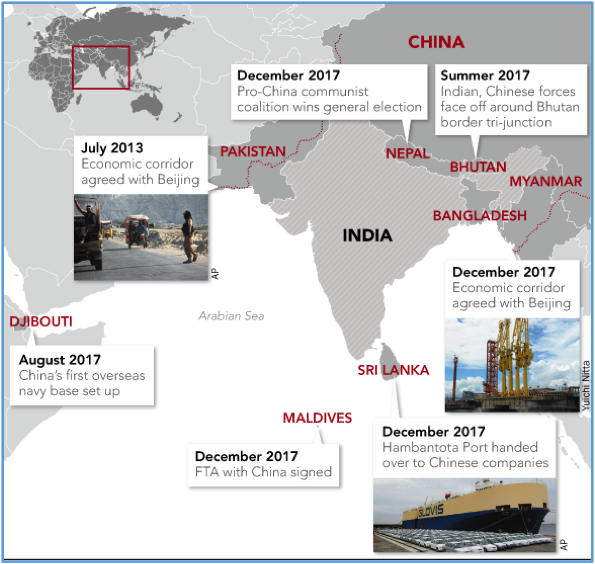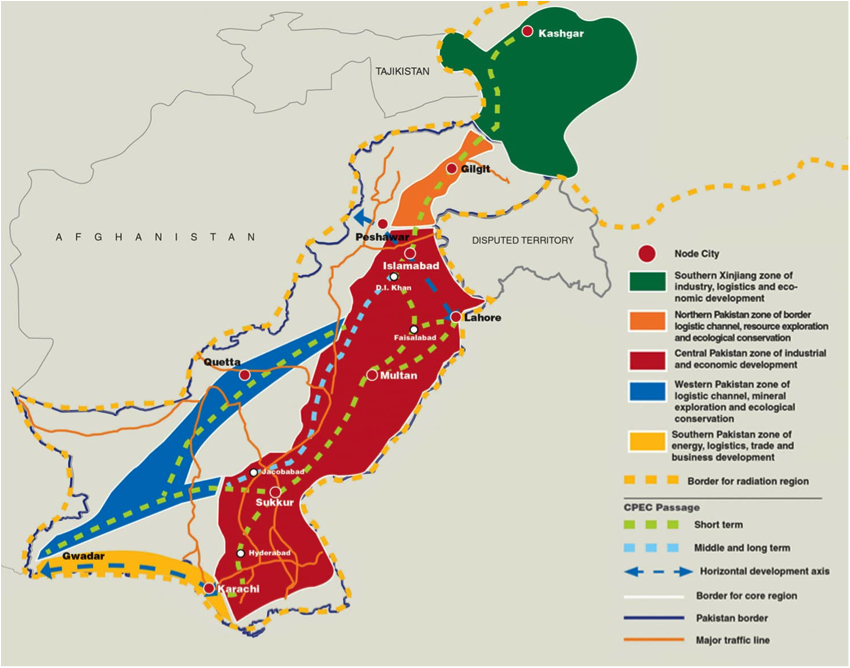Will CPEC Bring Political Stability to South Asia?
archive


port facility in Gwadar, Pakistan, a terminal of the China-Pakistan Economic Corridor project (CPEC). Photo credit: Anjum Naveed/AP
Will CPEC Bring Political Stability to South Asia?
China’s announcement of its $1 trillion Belt Road Initiative (BRI) ‘project of the century’ during the Belt and Road Forum in May 2017 was instantly interpreted by many OECD countries as yet another sign of the rising specter of Global China, with its serious potential to unsettle current regional and international alliances.1 With nearly 70 plus countries already on board, which account for around a third of the world’s countries, Belt and Road Initiative (BRI)-related projects are transforming the economic and political landscape of a number of countries neighboring China, whether they be in West Asia, South Asia, or Southeast Asia. Until recently, scholars rightly focused on the global dynamics unleashed by the current phase of hyper-globalization, but with perhaps less concern for how regions (countries) are interconnected with meta-regions (continents or sub-continents) and the global system. China’s BRI initiative provides an ideal opportunity to examine the enmeshing of these different geographical spaces within the global polity. In a previous global-e essay the focus was on BRI’s impact on Sino-India relations; this essay extends it to the evolving China-Pakistan-India nexus in South Asia.2
Over the past couple of years, BRI-linked corridor projects—for example, the China-Pakistan Economic Corridor (CPEC) in Pakistan on India’s western border, the Bangladesh-China-India-Myanmar Corridor (BCIMC) on its eastern border, along with China’s infrastructure projects in the Indian Ocean, especially in Bangladesh, Sri Lanka, and Pakistan—have emerged as major sources of tension. India dreads these activities, as they provide China a platform for building a network of naval and military bases labeled a ‘string of pearls’ around the neck of ‘Mother’ India, thereby directly challenging its sphere of influence (see Figure 1). Further, the election of a pro-China government in Nepal and recent Chinese-funded railroad projects designed to connect to its northern, Himalayan border, have added further tension, with some critics already lamenting India’s loss of Nepal to China. All these developments have the potential to make the South Asian region even more unstable.

Figure 1. BRI and ‘Pearl of Strings’ as Perceived by India. Source: Kuronoma (2017)
CPEC and Indo-Pakistan Rivalry
China and Pakistan have a seventy year ‘special’ relationship based largely on economic and military connections. Nevertheless, the CPEC project announced in 2015 aroused new Indian suspicions about China-Pakistan motives, with their potential to escalate tensions, especially given the ongoing border disputes as shown in Figure 2. India’s objection to CPEC rests primarily on the argument that it passes through the Gilgit-Baltistan areas of ‘Pak-occupied Kashmir’ (PoK), which India claims as its territory, and therefore infringing its sovereignty. Further, the increased Chinese presence in Pakistan, with an estimated 30,000 Chinese workers employed on various CPEC projects and protected by 20,000 Pakistani troops, reinforces the perception that the threat is serious, akin to opening up yet another Line of Actual Control near India’s western border.
Much like the 7-star Burj Al Arab in Dubai, CPEC can be considered the ‘crown jewel’ of BRI, with China planning to invest around $62bn in Pakistan as part of its Long Term Plan (2017-2030). CPEC aims to raise Pakistan’s power generation capacity and build new roads, seaports, airports, and industrial parks in earmarked special economic zones. It will also develop agro-industry and agro-processing units utilizing thousands of acres of agricultural land, and lay fiber-optic cables for internet connectivity (Economist, 2017; Wolf, 2016). However, beyond infrastructure and industry, the CPEC plan also envisages developing a 24x7 surveillance system that would monitor not only cities, roads, railway stations, and busy market places to ensure internal security, but also detect external threats.

Figure 2: Map showing segments of Northern, Eastern and Western borders that are contested between India, China and Pakistan and have been cause of conflict. Source: The Economist (2010)
Supporters of CPEC, acknowledging China and Pakistan as ‘all-weather friends’, view this initiative as a ‘fate changer’, with its potential to transform Pakistan towards a rich country status—which past dependency on U.S. and IMF-World Bank economic aid over several decades failed to do. Projects associated with CPEC are by all accounts progressing well and are intended to connect the Chinese city of Xinjiang with the Gwadar and Karachi ports (in Pakistan’s provinces of Balochistan and Sind respectively) on the Arabian Sea, as can be seen in Figure 3 below.
The significance of the Karachi and Gwadar port facilities for China can’t be underestimated. When fully operational they will become major trans-shipment points for China’s energy and resource needs and thereby reduce China’s dependency on the Straits of Malacca sea-route, ensuring greater energy security. Further, the Gwadar port in particular not only provides easier land-route access to China’s western provinces but also gives China direct access to the Persian Gulf and the Horn of Africa—including its naval base in Djibouti—via the Arabian Sea and the south Indian Ocean (Roberts, 2018).
India dreads these activities, as they provide China a platform for building a network of naval and military bases labeled a ‘string of pearls’ around the neck of ‘Mother’ India, thereby directly challenging its sphere of influence.
However, CPEC has morphed into a controversial project both within Pakistan itself and of course with the India government. All political parties and provincial leaders initially welcomed CPEC, acknowledging that it would bring unprecedented socio-economic transformation and prosperity and serve Pakistan’s strategic and regional interests (Chawla, 2017). Nevertheless, this excitement and optimism was short-lived; soon after, some Pakistani skeptics demanded greater transparency and more detailed information on CPEC’s financing and its economic and environmental impacts, especially the latter if lower grade coal extracted from the $2 billion Thar mine project becomes the major input for power-generation.3 Skeptics furthermore wonder when the projects will begin to bear fruit for ordinary citizens and if there will be tangible spillover benefits for all Pakistan provinces. Some of the harsher critics even claimed that CPEC was nothing other than Pakistani elites selling out the country’s assets and resources to China, reminiscent of plunder by the East India Company in an earlier period. These critics also point to the danger of Pakistan becoming perpetually indebted to China, with its potential to cause chronic foreign exchange crises. Dawn, Pakistan’s leading business and finance weekly, on gaining exclusive access to the ‘CPEC Master Plan’, lamented that CPEC may well end up creating Chinese-only economic and leisure zones within Pakistan rather than developing the country as a whole (Hussain, 2017).

Figure 3: CPEC Projects Linking Kashgar (Xinjiang Uygur Autonomous Region in China) with Karachi and Gwadar Ports (Pakistan). Source: Dawn (2017)
Indian Responses to CPEC
Mindful of the perceived threats posed by BRI-related projects surrounding it, India’s response has been to consolidate its own sphere of influence in South Asia by developing greater connectivity through the completion of several infrastructure projects. For example, a number of bridges and roads have been built in Bangladesh, Nepal, and Sri Lanka as well as in its north-eastern border states, to provide greater civilian and military connectivity. Linter convincingly argues that the rivalry between China and India has also spilled over to Myanmar and the Indian Ocean, with both China and India vying for influence in the ‘great game east’ (Linter, 2015).
India has also begun to consolidate its strategic interests in West Asia under its ‘Look West’ policy. For instance, recently India and Afghanistan inaugurated a dedicated air freight corridor to boost bilateral trade, providing landlocked Afghanistan greater access to the Indian market. Other potential access routes are also under consideration, for example, India signing a trilateral agreement with Afghanistan and Iran to develop the Chabahar Port, ensuring greater energy security. Many of these initiatives are clearly designed to directly counterbalance China’s CPEC initiative.
One should not underrate the fact that India-Pakistan relations are governed by a bitter cold war environment. CPEC has added yet another ingredient, unleashing a new propaganda war in South Asia. Conspiracy theories, fake news, and misinformation about ‘real motives’ of ‘enemy States’ are quite common, often emanating from the amorphous RAW and ISI intelligence apparatus.4 China, in response, watches and continues to re-assure Pakistan that it is fully committed to CPEC and that their continued efforts at détente with India will not affect their special relationship. China also encourages Pakistan to stay focused on re-building its economy rather than escalating tensions with India.
China, BRI and CPEC: Potential Roadblocks and Breakthrough?
Given that several CPEC projects are completed, others appear to be progressing well and additional money is already committed, their impact on Pakistan’s economic landscape is both real and clearly visible. And we are only a few years into the Long Term Plan, not due to be completed until 2030. Neighboring countries are close observers, and despite growing concerns regarding potential debt impacts—the Sri Lankan debt-for-equity swap over Port of Hambantota is repeatedly cited as example of potential negative consequences— considerable progress has been made in the past three years even considering a slowdown in the pace of some projects as well as funding and bureaucratic delays.
One should not underrate the fact that India-Pakistan relations are governed by a bitter cold war environment. CPEC has added yet another ingredient, unleashing a new propaganda war in South Asia.
China is acutely aware of potential roadblocks to the success of CPEC and even ultimately to BRI, and is thus eager to get India fully on board since India’s support may prove critical in the coming years. The ‘strategic communication’ between Modi and Xi in Wuhan, China in late April 2018 underlined the importance of Sino-India dialogue, and the public announcement of a joint project between China and India in Afghanistan may well signal further partnerships going forward. At the same time, there may also be a belated realization by India that carving the path of resistance against BRI was a rather hasty and knee-jerk reaction to mounting fears of a Chinese empire-in-the making. This anxiety explains India’s posture focused largely on sovereignty and strategic concerns rather than perceiving Global China as a positive sum game with its potential to bring enormous benefits to Indian corporate and banking sectors. Yet, despite the hawkish rhetoric between them, China remains a major investor in India with FDI inflows estimated at $26 billion during 2014-2017. Indian ambivalence and participation in BRI may well shift in coming years, and the recent agreement on participating in joint projects in Afghanistan or elsewhere is a welcome step forward and one that may also, hopefully, have positive effects on the troubled relations between India and Pakistan.
1. $1 trillion is the planned expenditure on BRI projects according to Fitch Ratings' Report: China's One Belt, One Road Initiative Brings Risks (January 25, 2017). The final expenditure is expected to be several trillion dollars.
2. See http://www.21global.ucsb.edu/global-e/november-2017/chinese-dreams-indian-nightmares-does-bri-imply-collision-course
3. Mohiuddin Aazim, quotes Pakistan Business Council’s document ‘Agenda for the Economy’ released in November 2017, which noted: “There needs to be greater transparency on how the CPEC will impact the competitiveness of existing domestic industries and the safeguards that will be deployed to prevent it from becoming a channel of cheap imports.”
4. For example, press releases, from both the Indian and Pakistani press, often provide misleading details about the progress of projects, on how China imports inmates to work on its projects, the fraudulent use of ATM machines by Chinese workers, or about cultural tensions between Chinese migrants and local residents. Under these circumstances it becomes difficult to make a reasoned assessment. Within Pakistan itself, critics of CPEC point to China’s growing economic dominance, with some even viewing it as part of a larger plot by Punjabis to consolidate their stranglehold over non-Punjabis (as is already apparent in the military). However, supporters of CPEC in Pakistan counter by saying that foreign powers (read India) and domestic terrorist groups use negative propaganda given their determination to sabotage the CPEC project.
Aazim, Mohiuddin (2017). “CPEC’s precarious balancing act.” Dawn, December 7.
Chawla, Mohammad Iqbal (2017). “One Belt One Road Summit 2017 and its Implications for CPEC: An Overview.” Research Journal of South Asian Studies, Vol. 32, No. 2, July-December, pp. 277-284.
Hussain, Khurram (2017). “Exclusive CPEC Master Plan Revealed.” Dawn, May 18.
Linter, Bertil (2015). Great Game East: India, China, and the Struggle for Asia’s Most Volatile Frontier. Yale University Press.
Kuronuma, Yuji (2017). “China has India surrounded in their new Great Game.” Nikkei Asian Review, 19 December 9
Roberts, Harry (2018). “The Rational Behind the China-Pakistan Economic Corridor: The View from Bejing,” in David Lane and Guichang Zhu (eds.) Changing Regional Alliances for China and the West. Lexington Books.
The Economist (2010). “A Himalayan Rivalry.” August 19.
The Economist (2017). “China makes Pakistan an offer it cannot refuse.” July 22.
The Economist (2018) “China and India are trying to get along.” April 26.
Wolf, Siegfried O. (2016). “The China-Pakistan Economic Corridor: An Assessment of its Feasibility and Impact on Regional Cooperation.” South Asia Democratic Forum, Working Paper No 1.



